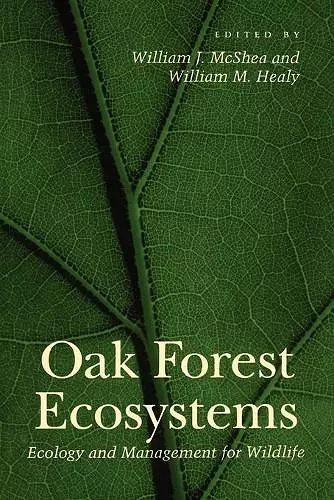Oak Forest Ecosystems:
William J McShea author William J McShea editor
Format:Paperback
Publisher:Johns Hopkins University Press
Published:25th Nov '03
Currently unavailable, and unfortunately no date known when it will be back

An essential reference for forest wildlife biologists, conservationists, land stewards, and researchers who want to know about North American oak forests, their ecology, management, and importance to wildlife. This volume presents the state of science on the topic; it is comprehensive, carefully organized, and highly readable. -- Richard M. DeGraaf, Chief Research Wildlife Biologist U.S. Forest Service
S. Department of Agriculture Forest ServiceOak Forest Ecosystems focuses on the relationship between an oak forest's acorn yield and species of wildlife that depend on it. It begins by treating factors such as oak distribution, forest fires, tree diseases and pests, dynamics of acorn production, and acorn dispersal by birds and mammals. Special consideration is given to the phenomenon of masting-whereby oaks in a given area will produce huge crops of acorns at irregular intervals-a key component for wildlife researchers and managers in understanding patterns of scarcity and abundance in the creatures that feed on this crop. Relationships between oaks and animals such as mice, squirrels, turkeys, deer, and bear are discussed, as are the differences between eastern, southern Appalachian, southwestern, and California oak forests. Contributors: Marc D. Abrams, Pennsylvania State University * Patrick H. Brose, U.S. Department of Agriculture Forest Service * John P. Buonaccorsi, University of Massachusetts * Daniel Dey, U.S. Department of Agriculture Forest Service * Joseph S. Elkinton, University of Massachusetts * George A. Feldhamer, Southern Illinois University * Peter F. Folliott, University of Arizona * Lee E. Frelich, University of Minnesota * Cathryn H. Greenberg, U.S. Department of Agriculture Forest Service * William M. Healy, U.S. Department of Agriculture Forest Service * Roy L. Kirkpatrick, Virginia Polytechnic Institute and State University * Johannes M. H. Knops, University of Nebraska * Walter D. Koenig, University of California * Nelson W. Lafon, Virginia Department of Game and Inland Fisheries * Andrew M. Liebhold, U.S. Department of Agriculture Forest Service * William J. McShea, National Zoological Park Conservation and Research Center * William H. McWilliams, U.S. Department of Agriculture Forest Service * Gary W. Norman, Virginia Department of Game and Inland Fisheries * Steven W. Oak, U.S. Department of Agriculture Forest Service * Renee A. O'Brien, U.S. Department of Agriculture Forest Service * Richard S. Ostfeld, Institute of Ecosystem Studies * Bernard R. Parresol, U.S. Department of Agriculture Forest Service * Peter J. Perkins, University of New Hampshire * Gordon C. Reese, Colorado State University * Peter B. Reich, University of Minnesota * Peter D. Smallwood, University of Richmond * Christopher C. Smith, Kansas State University * Richard B. Standiford, University of California-Berkeley * Martin A. Stapanian, Ohio Cooperative Wildlife Unit * Michael A. Steele, Wilkes University * David Steffen, Virginia Department of Game and Inland Fisheries * David H. Van Lear, Clemson University * Michael R. Vaughan, Virginia Polytechnic Institute and State University * Karen L. Waddell, U.S. Department of Agriculture Forest Service
The information is a good starting point for managers and landowners who want to have a better understanding of their forests. -- Paul Jasinski Ecoscience 2003
ISBN: 9780801877476
Dimensions: unknown
Weight: unknown
452 pages